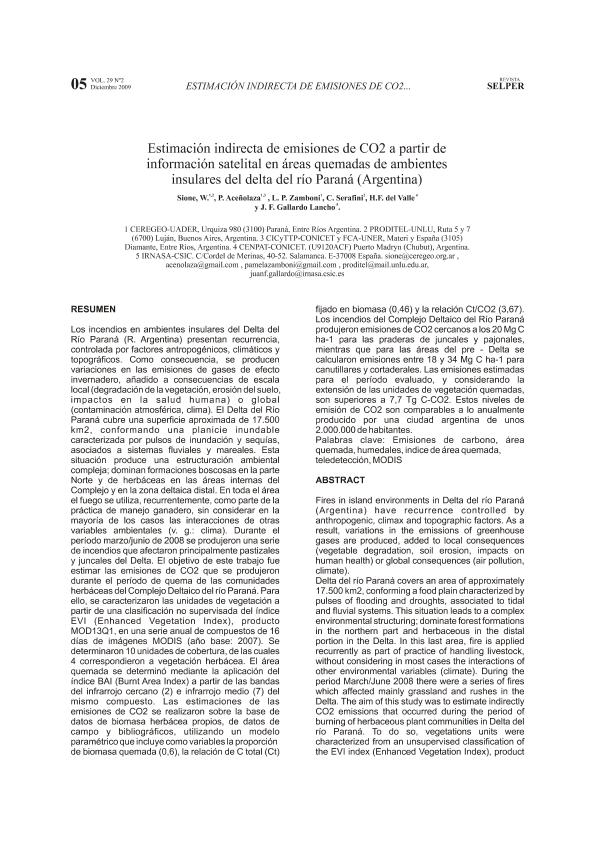Mostrar el registro sencillo del ítem
dc.contributor.author
Sione, Walter Fabian

dc.contributor.author
Aceñolaza, Pablo Gilberto

dc.contributor.author
Zamboni, Lisandra Pamela

dc.contributor.author
Serafini, Maria Cristina

dc.contributor.author
del Valle, Hector Francisco

dc.contributor.author
Gallardo Lancho, Juan
dc.date.available
2019-07-25T21:06:26Z
dc.date.issued
2009-12
dc.identifier.citation
Sione, Walter Fabian; Aceñolaza, Pablo Gilberto; Zamboni, Lisandra Pamela; Serafini, Maria Cristina; del Valle, Hector Francisco; et al.; Estimación indirecta de emisiones de CO2 a partir de información satelital en áreas quemadas de ambientes insulares del delta del río Paraná (Argentina); Sociedad Latinoamericana de Percepción Remota y Sistemas de Información Geográfica; Journal SELPER; 29; 2; 12-2009; 5-21
dc.identifier.issn
0717-2915
dc.identifier.uri
http://hdl.handle.net/11336/80330
dc.description.abstract
Fires in island environments in Delta del río Paraná (Argentina) have recurrence controlled by anthropogenic, climax and topographic factors. As a result, variations in the emissions of greenhouse gases are produced, added to local consequences (vegetable degradation, soil erosion, impacts on human health) or global consequences (air pollution, climate). Delta del río Paraná covers an area of approximately 17.500 km2, conforming a food plain characterized by pulses of flooding and droughts, associated to tidal and fluvial systems. This situation leads to a complex environmental structuring; dominate forest formations in the northern part and herbaceous in the distal portion in the Delta. In this last area, fire is applied recurrently as part of practice of handling livestock, without considering in most cases the interactions of other environmental variables (climate). During the period March/June 2008 there were a series of fires which affected mainly grassland and rushes in the Delta. The aim of this study was to estimate indirectly CO2 emissions that occurred during the period of burning of herbaceous plant communities in Delta del río Paraná. To do so, vegetations units were characterized from an unsupervised classification of the EVI index (Enhanced Vegetation Index), product MOD 13 Q1, in an annual series of compounds of 16 days of MODIS images (base year: 2007). Ten pieces of coverage coverage were identified; four of them corresponded to herbaceous vegetation. The burnt area was determined by applying the index BAI (Burnt Area Index) from bands from near infrared (2) and middle infrared (7) of the same compound. Estimates of CO2 emissions were made based on data from own herbaceous biomass, bibliographic and field data, using a parametric model that includes as variables of proportion of burnt biomass (0,6), the relation of C (Ct), total set in biomass (0,46) and the relation Ct/CO2 (3,67). Fires in Delta del Paraná produced CO2 emissions close to 20 Mg nC ha-1 for grasses and rushes prairies, while for the pre-Delta areas the emissions were estimate between 18 and 34 Mg C ha-1 for canutillares and cortaderales. Estimated emissions for the evaluated period are higher than 7,7 Tg C-CO2. These levels of CO2 emissions are comparable to the annually produced by an Argentinean city with 2.000.000 inhabitants.
dc.format
application/pdf
dc.language.iso
spa
dc.publisher
Sociedad Latinoamericana de Percepción Remota y Sistemas de Información Geográfica
dc.rights
info:eu-repo/semantics/openAccess
dc.rights.uri
https://creativecommons.org/licenses/by-nc-sa/2.5/ar/
dc.subject
Emisiones de Carbono
dc.subject
Area Quemada
dc.subject
Humedales
dc.subject
Indice de Area Quenada
dc.subject.classification
Ciencias Medioambientales

dc.subject.classification
Ciencias de la Tierra y relacionadas con el Medio Ambiente

dc.subject.classification
CIENCIAS NATURALES Y EXACTAS

dc.title
Estimación indirecta de emisiones de CO2 a partir de información satelital en áreas quemadas de ambientes insulares del delta del río Paraná (Argentina)
dc.type
info:eu-repo/semantics/article
dc.type
info:ar-repo/semantics/artículo
dc.type
info:eu-repo/semantics/publishedVersion
dc.date.updated
2019-07-22T13:17:35Z
dc.journal.volume
29
dc.journal.number
2
dc.journal.pagination
5-21
dc.journal.pais
Argentina

dc.journal.ciudad
Luján
dc.description.fil
Fil: Sione, Walter Fabian. Universidad Autónoma de Entre Ríos; Argentina. Universidad Nacional de Luján; Argentina
dc.description.fil
Fil: Aceñolaza, Pablo Gilberto. Universidad Autónoma de Entre Ríos; Argentina. Provincia de Entre Ríos. Centro de Investigaciones Científicas y Transferencia de Tecnología a la Producción. Universidad Autónoma de Entre Ríos. Centro de Investigaciones Científicas y Transferencia de Tecnología a la Producción. Consejo Nacional de Investigaciones Científicas y Técnicas. Centro Científico Tecnológico Conicet - Santa Fe. Centro de Investigaciones Científicas y Transferencia de Tecnología a la Producción; Argentina
dc.description.fil
Fil: Zamboni, Lisandra Pamela. Universidad Autónoma de Entre Ríos; Argentina
dc.description.fil
Fil: Serafini, Maria Cristina. Universidad Nacional de Luján; Argentina
dc.description.fil
Fil: del Valle, Hector Francisco. Consejo Nacional de Investigaciones Científicas y Técnicas. Centro Científico Tecnológico Conicet - Centro Nacional Patagónico; Argentina
dc.description.fil
Fil: Gallardo Lancho, Juan. Consejo Superior de Investigaciones Científicas; España
dc.journal.title
Journal SELPER
dc.relation.alternativeid
info:eu-repo/semantics/altIdentifier/url/https://selper.info/revista-selper/
Archivos asociados
